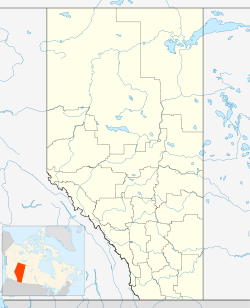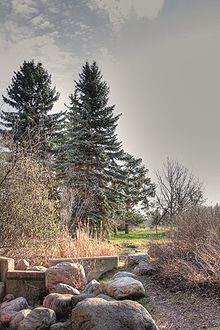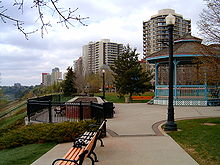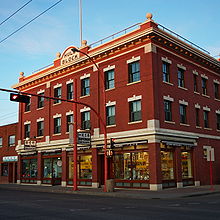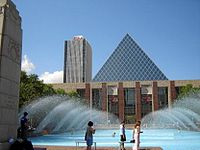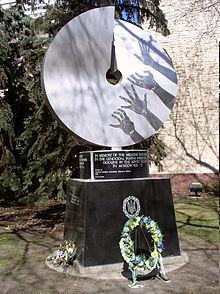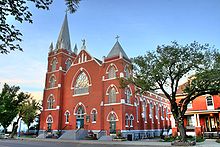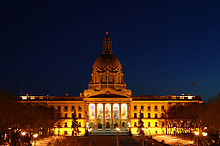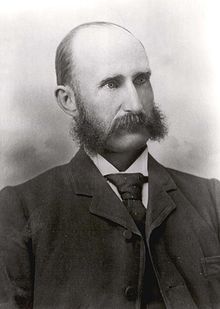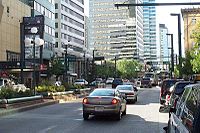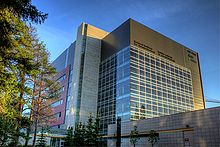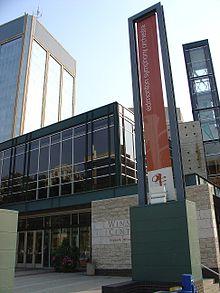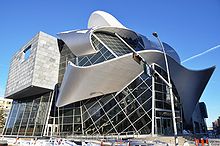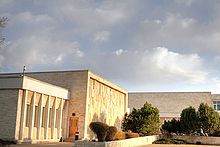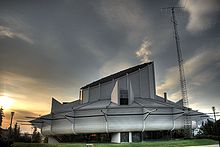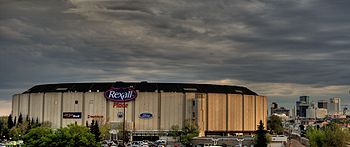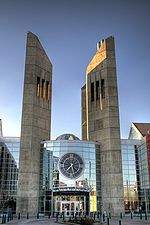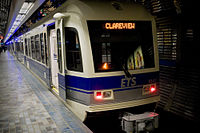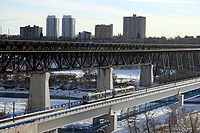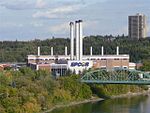- Edmonton
-
Edmonton — City — City of Edmonton From top left: Downtown Edmonton, Fort Edmonton Park, Legislature Building, Law Courts, Rexall Place, High Level Bridge, Muttart Conservatory 
Flag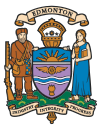
Coat of arms
LogoNickname(s): City of Champions, Gateway to the North, The Festival City, Deadmonton,[1][2] E-Town, River City, Oil Capital of Canada, Oil Country, Oil City Motto: Industry, Integrity, Progress Location of Edmonton in Alberta Coordinates: 53°34′N 113°31′W / 53.567°N 113.517°WCoordinates: 53°34′N 113°31′W / 53.567°N 113.517°W Country Canada Province Alberta Region Edmonton Capital Region Census division 11 Established 1795 Incorporated [3]
- Town
January 9, 1892- City October 8, 1904 Government - Mayor Stephen Mandel
(List of former mayors)- Governing body Edmonton City Council - Manager Simon Farbrother - MPs List of MPs- MLAs List of MLAsArea (2006)[4][5] - City 684.37 km2 (264.2 sq mi) - Metro 9,417.88 km2 (3,636.3 sq mi) Elevation 668 m (2,192 ft) Population (2006)[4][5] - City 730,372 (5th) - Density 1,067.2/km2 (2,764/sq mi) - Urban 862,544 - Metro 1,034,945 (6th) - Metro density 109.9/km2 (284.6/sq mi) - Demonym Edmontonian Time zone MST (UTC−7) - Summer (DST) MDT (UTC−6) Postal code span T5A to T6Z Area code(s) 780, 587 NTS Map 083H11 GNBC Code IACMP GDP per capita C$39,675 (est. 2010)[6] Average income per household C$98,857 (est. 2010) Website City of Edmonton Edmonton (
 /ˈɛdməntən/) is the capital of the Canadian province of Alberta and is the province's second-largest city. Edmonton is located on the North Saskatchewan River and is the centre of the Edmonton Capital Region, which is surrounded by the central region of the province.
/ˈɛdməntən/) is the capital of the Canadian province of Alberta and is the province's second-largest city. Edmonton is located on the North Saskatchewan River and is the centre of the Edmonton Capital Region, which is surrounded by the central region of the province.The city and its census metropolitan area had populations of 730,372[4] and 1,034,945[5] as of the 2006 Census respectively, making it the northernmost North American city with a metropolitan population over one million. The city's 2009 civic census showed a population of 782,439,[7] while Statistics Canada estimated its metropolitan population at 1,155,383 in 2009,[8] making it the sixth-largest metropolitan area in the nation. A resident of Edmonton is known as an Edmontonian.[9]
The majority of Edmonton's metropolitan population lives within the City of Edmonton rather than in the surrounding suburban municipalities. Historically Edmonton was surrounded by few other urban municipalities and many of the nearby settlements that did exist were absorbed through amalgamation or annexation. Edmonton annexed a significant amount of land up until the early 1980s, and as such it has sustained much of the region's suburban growth within the city.
Edmonton serves as the northern anchor of the Calgary–Edmonton Corridor and is a staging point for large-scale oil sands projects occurring in northern Alberta and large-scale diamond mining operations in the Northwest Territories.[10]
Edmonton is a cultural, governmental and educational centre. It plays host to a year-round slate of world-class festivals, earning it the title of "The Festival City."[11] It is home to North America's largest mall, West Edmonton Mall (the world's largest mall from 1981 until 2004),[12] and Fort Edmonton Park, Canada's largest living history museum.[13] In 2004, Edmonton celebrated the centennial of its incorporation as a city.[14]
Contents
History
Further information: History of Edmonton and Timeline of Edmonton history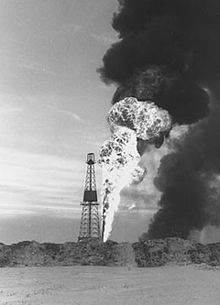 The original Leduc No. 1 oil well, now a monument located just south and west of the city; a replica stands at the southern entrance of Gateway Park on the Queen Elizabeth II Highway
The original Leduc No. 1 oil well, now a monument located just south and west of the city; a replica stands at the southern entrance of Gateway Park on the Queen Elizabeth II Highway
The first inhabitants settled in the area that is now Edmonton around 3,000 BC and perhaps as early as 12,000 BC, when an ice-free corridor opened up as the last ice age ended and timber, water, and wildlife became available in the region.[15]
In 1754, Anthony Henday, an explorer working for the Hudson's Bay Company (HBC), may have been the first European to enter the Edmonton area.[16] His expeditions across the Canadian Prairies were mainly to seek contact with the aboriginal population for the purpose of establishing the fur trade, as competition was fierce between the Hudson's Bay Company and the North West Company. By 1795, Fort Edmonton was established on the north bank of the river, as a major trading post for the Hudson's Bay Company.[17] The name of the new fort was suggested by John Peter Pruden after Edmonton, London, the home town of both the HBC deputy governor Sir James Winter Lake, and Pruden. In the late 19th century, the highly fertile soils surrounding Edmonton helped attract settlers, further establishing Edmonton as a major regional commercial and agricultural centre. Edmonton was also a stopping point for people hoping to cash in on the Klondike Gold Rush in 1897, although the majority of people doing so chose to take a steamship north to the Yukon from Vancouver.
Incorporated as a city in 1904 with a population of 8,350,[18] Edmonton became the capital of Alberta as the province joined Confederation a year later, on September 1, 1905.[19] In November 1905, the Canadian Northern Railway (CNR) arrived in Edmonton, accelerating growth.[20]
During the early 1910s, Edmonton grew very rapidly, causing rising speculation in real estate prices. In 1912, Edmonton amalgamated with the City of Strathcona, south of the North Saskatchewan River; as a result, the city extended south of the North Saskatchewan River for the first time.[21]
Just prior to World War I, the real estate boom ended suddenly, causing the city's population to decline sharply from over 72,500 in 1914 to under 54,000 only two years later.[22] Recruitment to the Canadian military during the war also contributed to the drop in population. Afterwards, the city was slow to recover in population and economy during the 1920s and 1930s until World War II.
The first licensed airfield in Canada, Blatchford Field (now Edmonton City Centre (Blatchford Field) Airport), commenced operation in 1929.[23] Pioneering aviators such as Wilfrid R. "Wop" May and Max Ward used Blatchford Field as a major base for the distribution of mail, food, and medicine to Northern Canada; hence Edmonton's role as the "Gateway to the North" was strengthened. World War II saw Edmonton becoming a major base for the construction of the Alaska Highway and the Northwest Staging Route.[24]
Geography
Edmonton is located near the geographic centre of the province, at an elevation of 668 metres (2,192 ft).[25] Edmonton is the most northerly city in North America with a metropolitan population of over one million. It is at the same latitude as Hamburg, Germany and Manchester, England. The terrain in and around Edmonton is generally flat to gently rolling, with ravines and deep river valleys, such as the North Saskatchewan River valley.[26] Despite the fact that the Canadian Rockies come as close to Edmonton as roughly 220 km (140 mi) to the southwest, the city is too distant for any of their peaks to be seen from even its tallest buildings.[27]
The North Saskatchewan River originates at the Columbia Icefield in Jasper National Park and bisects the city. It empties via the Saskatchewan River, Lake Winnipeg, and the Nelson River into Hudson Bay.[28] It runs from the southwest to the northeast and is fed by numerous creeks throughout the city, such as Mill Creek, Whitemud Creek and Blackmud Creek; this creates numerous ravines, many of which have been incorporated into urban parkland.[29] Edmonton is situated at the boundary between prairie to the south and boreal forest to the north, in a transitional area known as aspen parkland. However, the aspen parkland in and around Edmonton has long since been heavily altered by farming and other human activities, such as oil and natural gas exploration.[30]
Parkland and environment
Edmonton's river valley constitutes the longest stretch of connected urban parkland in North America, and Edmonton has the highest per capita area of parkland of any Canadian city; the river valley is 22 times larger than New York City's Central Park.[31] The public river valley parks provide a unique urban escape area, with park styles ranging from fully serviced urban parks to campsitelike facilities with few amenities. This main "Ribbon of Green" is supplemented by numerous neighbourhood parks located throughout the city, to give a total of 111 km2 (27,400 acres) of parkland.[31] Within the 7,400 ha (18,000 acres), 25 km (16 mi)-long river valley park system, there are eleven lakes, fourteen ravines, and twenty-two major parks, and most of the city has excellent bike and walking trail connections.[32] These trails are also part of the 235 km (146 mi) Waskahegan walking trail. The City of Edmonton has named five parks in its River Valley Parks System in honour of each of "The Famous Five".[33]
Edmonton's streets and parklands are also home to one of the largest remaining concentrations of healthy American elm trees in the world, unaffected by Dutch elm disease, which has wiped out vast numbers of such trees in eastern North America. Jack Pine, Lodgepole Pine, White Spruce, White Birch, Aspen, Mountain Ash, Amur Maple, Russian Olive, Green Ash, Basswood, Various Poplars and Willows, Flowering Crabapple, Mayday Tree and Manitoba Maple are also abundant; Bur oak, Silver Maple, Hawthorn and Ohio Buckeye are increasingly popular. Other introduced tree species include White Ash, Blue Spruce, Norway Maple, Red oak, Sugar Maple, Common Horse-chestnut, McIntosh apple, and Evans Cherry.[34] Three walnut species—Butternut, Manchurian walnut, and black walnut—have survived in Edmonton.[35]
Several golf courses, both public and private, are also located in the river valley; the long summer daylight hours of this northern city provide for extended play from early morning well into the evening.[36] Golf courses and the park system become a winter recreation area during this season, and cross-country skiing and skating are popular during the long winter. Four downhill ski slopes are located in the river valley as well, two within the city and two immediately outside.[37]
Neighbourhoods
Edmonton has numerous distinct neighbourhoods.[38] Downtown Edmonton consists of the Commercial Core, the Arts District, Rice Howard Way, McKay Avenue, Jasper-West, the Warehouse District and the Government Precinct (also known as Grandin). The Commercial Core and Rice Howard Way double as Edmonton's Central Business District and the Arts District is home to most of Edmonton's main cultural buildings like the Art Gallery of Alberta. The Warehouse District is home to some old brick warehouses (most have been converted to lofts and condominiums) from when the area was the City's main industrial area and at the same time is one of the most up and coming districts in the City with lots of new construction underway or planned. McKay Avenue is home to many residential towers and some of the Downtown hotels and is fairly quiet, compared to the Government District which is home to the lively Alberta Legislature and many government offices.[39]
Radiating from the core are many older urban neighbourhoods. Oliver, immediately west of Downtown Edmonton, is often mistakenly considered as part of the Downtown due to its high density condos and apartments. Between the old character homes of Westmount and mid and high rises of Oliver is 124 Street which is home to many art galleries and restaurants. Further west of Westmount is Glenora, where the Royal Alberta Museum is located and lots of beautiful old Scottish-inspired mansions. To the east of Downtown is Boyle Street which is one of the lower income neighbourhoods of the city and has many walk up apartments and old brick buildings. Northeast of Downtown is McCauley, which is one of the most ethnically diverse areas of the city and home to Edmonton's Little Italy and part of Edmonton's Chinatown. Also northeast of Downtown is Alberta Avenue and Parkdale, which are formerly run-down neighbourhoods that are undergoing revitalization with young families and artists moving in. Immediately across the river from Downtown Edmonton is Strathcona, which is full of character and home to the vibrant Whyte Avenue. Straddled between the main campus of University of Alberta and Strathcona is Garneau, which has many independent cafes and French-Canadian inspired homes. To the southeast of Downtown are neighbourhoods such as Cloverdale and Bonnie Doon, which are relatively quiet. Bonnie Doon Shopping Centre is located within Bonnie Doon and the Muttart Conservatory is located within Cloverdale.[39]
Edmonton then gives way to matured suburbs that first began to appear in the 1940s through to around 1970. Neighbourhoods such as Strathearn, Rundle Heights, Jasper Park, and Empire Park have many 1950s and 1960s style walk up apartments and townhouse complexes alongside single family homes and mom and pop businesses. These neighbourhoods tend to not be thought of as much as suburbs as the post-1970 suburbs.
Post-1970 suburbs are much less matured and tend to not have back alleys for houses and instead opt for front-car garages so that cars are more convenient. One of the most well-known suburbs from the 1970s and 1980s is Mill Woods, a collection of neighbourhoods in southeast Edmonton. It is often incorrectly referred to as "Millwoods," due to a typographical mistake on street signs dating back to the neighbourhood's inception. Other areas where new suburbs popped up in the 1970s and 1980s into the early 1990s are Belmont and Kirkness in the area generally considered "Clareview" in Northeast Edmonton; areas around Blue Quill and Lendrum Place in the southwest; and areas around Belmead and Callingwood in the west.
Most of the newer suburban growth in the City of Edmonton has occurred in Southwest Edmonton around Terwillegar. More recently, many new suburban neighbourhoods have begun to pop up outside of Edmonton's ring road, Anthony Henday Drive, such as Summerside, Ellerslie, Windermere, The Hamptons, and Rutherford. Many of these are home to small recreational lakes and newer suburban strip malls. Still, there are many new neighbourhoods going up within the ring road, such as The Meadows, east of Mill Woods and Carlton and Cumberland in Northwest Edmonton east of St. Albert Trail.
Several transit-oriented developments (TOD) have begun to appear along the LRT line at Clareview, with future developments planned at Belvedere (part of the Old Town Fort Road Redevelopment Project).[40] Another TOD, called Century Park,[41] is being constructed at the site of what was once Heritage Mall, at the southern end of the LRT line. Century Park will eventually house up to 5,000 residents.[42] The Edmonton City Centre airport is planned to be developed into a TOD.
Metropolitan area
Edmonton is at the centre of Canada's sixth largest census metropolitan area (CMA) that includes Edmonton and 34 other municipalities in the surrounding area. Larger communities include the Urban Service Area of Sherwood Park (part of Strathcona County), the cities of St. Albert, Leduc, Spruce Grove and Fort Saskatchewan, and the towns of Stony Plain, Beaumont, Morinville, and Devon. Major employment areas outside of Edmonton but within the CMA include the Nisku Industrial Business Park and the Edmonton International Airport/Port Alberta in Leduc County, the Acheson Industrial Area in Parkland County, Refinery Row in Strathcona County and Alberta's Industrial Heartland within portions of Fort Saskatchewan, Strathcona County and Sturgeon County. Alberta's Industrial Heartland also extends beyond the CMA's northeastern boundary into a portion of Lamont County.
The individual economic development interests and costs of service delivery in certain municipalities within the region has led to intermunicipal competition, strained intermunicipal relationships and overall fragmentation of the region. Although several attempts have been made by the City of Edmonton to absorb surrounding municipalities[43] or annex portions of its neighbours,[44] the city has not absorbed another municipality since the Town of Jasper Place joined Edmonton on August 17, 1964[45] and the city has not annexed land from any of its neighbours since January 1, 1982.[46] After years of mounting pressure in the early 21st century, the Province of Alberta formed the Capital Region Board (CRB) on April 15, 2008.[47] The CRB consists of 24 member municipalities – 22 of which are within the Edmonton CMA and two of which are outside the CMA.
Climate
Edmonton has a relatively dry humid continental climate (Koppen climate classification Dfb, USDA Plant Hardiness Zone 3a)[48][49][50] with extreme seasonal temperatures—although the city has milder winters than either Regina or Winnipeg, both located at a latitude farther south. It has warm summers and cold winters, with the average daily temperatures ranging from −11.7 °C (10.9 °F) in January to 17.5 °C (63.5 °F) in July.[51] Annually, temperatures exceed 30 °C (86 °F) on an average of four to five days (but can occur often, anytime from late April to mid September) and fall below −20 °C (−4 °F) on an average of 28 days. The highest temperature recorded within the City of Edmonton was 38.3 °C (100.9 °F), on August 5, 1998.[52] Some areas, however, such as the City of St. Albert and Sherwood Park, recorded temperatures of 37.7 °C (99.9 °F) on July 22, 2006. The coldest temperature ever recorded at city centre was −40.6 °C (−41.1 °F) on January 26, 1972[53] - this was the only time since recordings began in 1953 that city centre has recorded a temperature below −40 °C (−40 °F). The coldest overall temperature recorded in Edmonton was −49.4 °C (−56.9 °F), on January 19 and 21, 1886.[54]
The year 2006 was a particularly warm one for Edmonton, as temperatures reached 29 °C (84 °F) or higher more than twenty times during the year, from as early as Mid-May and again in early September. Typically, summer lasts from late June until late August, and the humidity is seldom uncomfortably high. Winter lasts from November to March, and varies greatly in length and severity. Spring and autumn are both short and highly variable. Edmonton's growing season is from May 7 to September 23;[55] Edmonton averages 140 frost free days a year.[56] At the summer solstice, Edmonton receives seventeen hours and six minutes of daylight, with twilight extending throughout the entire night during summer.[57] Edmonton receives 2,299 hours of sunshine per year and is one of Canada's sunniest cities.[51]
Edmonton has a fairly dry climate. On average, Edmonton receives 476.9 millimetres (18.78 in) of precipitation, of which 365.7 millimetres (14.40 in) is rain and 111.2 millimetres (4.38 in) is the melt from 123.5 centimetres (48.6 in) of snowfall per annum.[51] Precipitation is heaviest in the late spring, summer, and early autumn. The wettest month is July, while the driest months are February, March, October, and November.[51] In July, the mean precipitation is 91.7 mm (3.61 in).[51] Droughts are not uncommon and may occur at any time of the year. Extremes do occur, such as the 114 mm (4.49 in) of rainfall that fell on July 31, 1953.[51] Summer thunderstorms can be frequent and occasionally severe enough to produce large hail, damaging winds, funnel clouds, and even tornadoes. However, tornadoes near Edmonton are far weaker and short-lived compared to their counterparts farther south. Dangerous weather events are rare in Edmonton, and the F4 tornado that struck Edmonton on July 31, 1987, killing 27, was unique in many respects, including severity, duration, damage, and casualties. It is commonly referred to as Black Friday due both to its aberrant characteristics and the emotional shock it generated.[58]
A massive cluster of thunderstorms occurred on July 11, 2004, with large hail and over 100 mm (3.94 in) of rain reported within the space of an hour in many places.[59] This "1-in-200 year event" flooded major intersections and underpasses and damaged both residential and commercial properties. The storm caused extensive damage to West Edmonton Mall; a small glass section of the roof collapsed under the weight of the rainwater, causing water to drain onto the mall's indoor ice rink. As a result, the mall was forced to undergo an evacuation as a precautionary measure.[60]
Climate data for Edmonton City Centre (Blatchford Field) Airport Month Jan Feb Mar Apr May Jun Jul Aug Sep Oct Nov Dec Year Record high °C (°F) 11.7
(53.1)14.0
(57.2)23.9
(75.0)31.1
(88.0)32.3
(90.1)34.4
(93.9)34.4
(93.9)34.5
(94.1)33.9
(93.0)28.6
(83.5)21.7
(71.1)16.7
(62.1)34.5
(94.1)Average high °C (°F) −7.3
(18.9)−3.6
(25.5)2.1
(35.8)11.3
(52.3)17.6
(63.7)21.0
(69.8)22.8
(73.0)22.1
(71.8)16.8
(62.2)10.9
(51.6)0.0
(32.0)−5.4
(22.3)9.0 Daily mean °C (°F) −11.7
(10.9)−8.4
(16.9)−2.6
(27.3)5.5
(41.9)11.7
(53.1)15.5
(59.9)17.5
(63.5)16.6
(61.9)11.3
(52.3)5.6
(42.1)−4.1
(24.6)−9.6
(14.7)3.9 Average low °C (°F) −16
(3)−13.1
(8.4)−7.3
(18.9)−0.3
(31.5)5.7
(42.3)10.0
(50.0)12.1
(53.8)11.1
(52.0)5.8
(42.4)0.3
(32.5)−8.2
(17.2)−13.9
(7.0)−1.2 Record low °C (°F) −44.4
(−47.9)−46.1
(−51.0)−36.1
(−33.0)−25.6
(−14.1)−12.2
(10.0)−1.1
(30.0)0.6
(33.1)−1.2
(29.8)−11.7
(10.9)−25
(−13)−34.1
(−29.4)−48.3
(−54.9)−48.3
(−54.9)Precipitation mm (inches) 22.5
(0.886)14.6
(0.575)16.6
(0.654)26.0
(1.024)49.0
(1.929)87.1
(3.429)91.7
(3.61)69.0
(2.717)43.7
(1.72)17.9
(0.705)17.9
(0.705)20.9
(0.823)476.9
(18.776)Rainfall mm (inches) 1.3
(0.051)0.9
(0.035)2.1
(0.083)13.1
(0.516)45.1
(1.776)87.1
(3.429)91.7
(3.61)68.9
(2.713)42.3
(1.665)10.5
(0.413)1.9
(0.075)0.8
(0.031)365.7
(14.398)Snowfall cm (inches) 24.5
(9.65)15.8
(6.22)16.8
(6.61)13.4
(5.28)3.5
(1.38)0
(0)0
(0)0
(0)1.5
(0.59)7.8
(3.07)17.9
(7.05)22.3
(8.78)123.5
(48.62)Avg. precipitation days 11.9 8.6 8.4 7.8 11.3 14.3 14.4 12.4 9.8 7.0 9.1 10.9 125.9 Avg. rainy days .93 .97 1.2 5.1 10.8 14.3 14.4 12.4 9.5 5.0 1.7 .83 77.13 Avg. snowy days 11.7 8.2 7.8 4.0 1.0 0 0 .03 .60 2.5 7.9 10.6 54.33 Sunshine hours 95.0 121.2 172.9 237.6 277.5 279.7 305.6 278.5 184.3 166.8 101.3 78.7 2,299.1 Source no. 1: Environment Canada[51] Source no. 2: Environment Canada [61] Demographics
According to the 2006 census, there were 730,372 residents within the city of Edmonton proper, compared to 3,290,350 for all of Alberta. The total population of the Census Metropolitan Area (CMA) was 1,034,945.[4][5] In 2009, a municipal census showed the city had a population of 782,439.[7][62]
In the five years between 2001 and 2006, the population of the city of Edmonton proper grew by 9.6%, compared with an increase of 10.4% for the Edmonton CMA and 10.6% for Alberta as a whole. The population density of the city of Edmonton proper averaged 1,067.2 people per square kilometre (2,764/sq mi), compared with an average of 5.1 people per square kilometre (13.2/sq mi) for Alberta altogether.[4]
In mid-2006, 11.9% of Edmonton's population were of retirement age (65 and over for males and females) compared with 13.7% in Canada.[4] The median age was 35.3 years of age, compared to 37.6 years of age for all of Canada. Also, according to the 2006 census, 50.5% of the population within the city of Edmonton proper were female, while 49.5% were male. Children under five accounted for approximately 5.6% of the resident population of Edmonton. This compares with 6.2% in Alberta, and almost 5.3% for Canada overall.[4]
In 2006, people of European ethnicities formed the largest cluster of ethnic groups in Edmonton, mostly of English, Scottish, German, Irish, Ukrainian, and French origin.[63] According to the 2006 census, the city of Edmonton was 71.8% White and 5.3% Aboriginal, while visible minorities accounted for 22.9% of the population.[4]
Religion
Main article: Religion in EdmontonAccording to the 2001 census, 31.2% of Edmonton residents are Protestant and 29.4% are Catholic. 5.5% belong to other Christian denominations, 2.9% are Muslim, 0.6% are Jewish, 5.1% are adherents of other religions, and 24.4% profess no religion.[64] One of Alberta's three Bahá'í Centres is located in Edmonton; the other two centres are situated in Sylvan Lake, Alberta, and Athabasca, Alberta. The first mosque established in Canada-the Al-Rashid Mosque, founded by Abdullah Yusuf Ali—is situated in Edmonton.[65] Edmonton also hosts a Maronite Catholic church, on 76th Avenue/98th Street, with services in English on Saturdays and Arabic on Sundays. The Lebanese community also has a Druze Community Centre on the north side of the city. The Edmonton Alberta Temple of the Church of Jesus Christ of Latter-day Saints was dedicated on December 11, 1999. The Hindu Community in Edmonton is served by the Hindu Society of Alberta[66] (North Indian Temple) and the Maha Ganapathy Society of Alberta (South Indian Temple).[67] The Sikh community in Edmonton is served by four gurdwaras. The Jewish Community in Edmonton is served by Jewish Federation of Edmonton.[68] The region is served by five synagogues.[69] Edmonton is also home to two of Alberta's four Unitarian Universalist congregations—the Unitarian Church of Edmonton[70] and the Westwood Unitarian Congregation;[71] the other two are located in Calgary and Lethbridge.[72]
Politics
In 1892 Edmonton was incorporated as a town. The first mayor was Matthew McCauley, he quickly established the first school board in Edmonton and Board of Trade (later Chamber of Commerce) and a municipal police service.[73] Due to mayor McCauley's good relationship with the federal Liberals this helped Edmonton to maintain political prominence over Strathcona, a town on the south banks of the North Saskatchewan River.[73] Edmonton was incorporated as a city in 1904 and became the capital of Alberta in 1905.
Municipal representation
Edmonton is represented by a mayor and 12 councillors - one for each of the 12 wards. On July 22, 2009 City Council adopted an electoral system that divides Edmonton into 12 wards, instead of the previous two for each of six wards. This system came into effect with the most recent municipal election in October 2010.[74]
Provincial representation
Edmonton is the capital of the province of Alberta and holds all main provincial areas of government such as the Provincial Legislature of Alberta. The Edmonton region is represented by 20 MLAs one for each provincial electoral district. Many of these boundaries have been changed, adjusted and renamed while the city has grown.[75]
Economy
Edmonton is the major economic centre for northern and central Alberta and a major centre for the oil and gas industry. In its autumn 2007 Metropolitan Outlook, the Conference Board of Canada forecast that Edmonton's GDP for 2007 will be $44.1-billion (2007 dollars), a 3.6% increase over 2006.[76] The Edmonton Economic Development Corporation estimated that as of January 2005, the total value of major projects under construction in northern Alberta was $81.5-billion, with $18.2-billion occurring within Greater Edmonton.[77]
Edmonton traditionally has been a hub for Albertan petrochemical industries, earning it the nickname "Oil Capital of Canada" in the 1940s.[78] Supply and service industries drive the energy extraction engine, while research develops new technologies and supports expanded value-added processing of Alberta's massive oil, gas, and oil sands reserves. These are reported to be the second-largest in the world, after Saudi Arabia.[79]
Despite the apparent focus on oil and gas, Edmonton's economy is one of the most diverse in Canada.[80] Major industrial sectors include a strong technology sector anchored by major employers such as IBM, Telus, Intuit Canada, Canadian Western Bank, BioWare, Matrikon, General Electric, and Stantec Inc.[81] The associated biotech sector, with companies such as Afexa Life Sciences Inc. (formerly CV Technologies).
Much of the growth in technology sectors is due to Edmonton's reputation as one of Canada’s premier research and education centres. Research initiatives are anchored by educational institutions such as the University of Alberta as well as government initiatives underway at the Alberta Research Council and Edmonton Research Park. Recently, the National Institute for Nanotechnology was constructed on the University of Alberta campus.[82]
During the 1970s and 1980s, Edmonton started to become a major financial centre, with both regional offices of Canada's major banks and locally based institutions opening.[83] However, the turmoil of the late-1980s economy radically changed the situation. Locally based operations such as Principal Trust and Canadian Commercial Bank[84] would fail, and some regional offices were moved to other cities. The 1990s saw a solidification of the economy, and Edmonton is now home to Canadian Western Bank, the only publicly traded Schedule I chartered bank headquarters west of Toronto.[85] Other major financial centres include ATB Financial, Servus Credit Union (formerly Capital City Savings), TD Canada Trust and Manulife Financial.[86]
Edmonton has been the birthplace of several companies that have grown to international stature, such as PCL Construction, Stantec Inc.[87][88] and more recently, Capital Power Corporation. The local retail market has also seen the creation of many successful store concepts, such as The Brick, Katz Group, AutoCanada, Boston Pizza, Pizza 73, Liquor Stores GP (which includes Liquor Depot, Liquor Barn, OK Liquor, and Grapes & Grains), Planet Organic, Empire Design, Running Room, Booster Juice, Earl's, Fountain Tire and XS Cargo.[89]
Edmonton's geographical location has made it an ideal spot for distribution and logistics. CN Rail's North American operational facility is located in the city, as well as a major intermodal facility that handles all incoming freight from the port of Prince Rupert in British Columbia.[90]
Edmonton was judged to have the "best economic potential" of any North American city by the Financial Times publication, FDi magazine.[91] In a 2007 study, FDI placed Edmonton immediately ahead of Mississauga, Ontario; Charlotte, North Carolina; Tijuana, Mexico and Calgary among cities with populations between 500,000 and two million. Edmonton's economic potential, expanding infrastructure, human resources, cost effectiveness, and high standard of living place it in the No. 4 spot on FDi’s list of top-ten North American large cities. The survey also named Edmonton in the top-five large North American cities for business development and investment promotion.[92] Edmonton is known for its exceptional environmental stewardship, strong life-science sector, and burgeoning high-tech industry economy.[93]
Retail
Edmonton is home to several shopping malls, including Canada's first mall, Westmount Centre (still in operation but under redevelopment) and West Edmonton Mall, one of the world's largest malls and presently the largest in North America. Other malls include Bonnie Doon Shopping Centre, Edmonton City Centre (a combination of the former Edmonton Centre and Eaton Centre malls), Southgate Centre, Kingsway Mall, Northgate Centre, Abbotsfield Mall, Londonderry Mall, Capilano Mall, and Mill Woods Town Centre.[94]
Edmonton also has many big box shopping centres and power centres. Some of the major ones include South Edmonton Common (North America's largest open air retail development),[95] Skyview Power Centre, Terra Losa Centre, Oliver Park, Southpark Centre, The Meadows, Christy's Corner, and Westpoint. In 2008, construction started on the Windermere power centre.[96]
In contrast to suburban centres, Edmonton has many urban retail locations. The largest of them all, Old Strathcona, includes many independent stores between 99 Street and 109th St on Whyte Avenue and area.[97] In around the downtown of Edmonton, there are a small handful of shopping districts such as previously mentioned Edmonton City Centre mall, Jasper Avenue and 104 Street. Near Oliver, 124 Street is home to a significant amount of retail stores.
Edmonton is the Canadian testing-ground for many American retailers such as Bath & Body Works and Calvin Klein.[98]
Culture
Many events are anchored in the downtown Arts District, centred around the recently renovated Churchill Square (named in honour of Sir Winston Churchill). On the south side of the river, the University district and Whyte Avenue contain theatres, concert halls, and various live music venues. Edmonton's current poet laureate is Mr. Roland Pemberton a.k.a. Mr. Cadence Weapon.[99]
- The Francis Winspear Centre for Music[100] was opened in 1997 after years of planning and fundraising.[101] Described as one of the most acoustically perfect concert halls in Canada, it is home to the Edmonton Symphony Orchestra and hosts a wide variety of shows every year. It seats 1,932 patrons and houses the $3-million Davis Concert Organ, the largest concert organ in Canada.[102] An interesting aspect of the hall's design is its separation into acoustically separate areas that are insulated from each other through acoustical barriers built into the structure. Patrons and artists can see these in the form of double-door "sound locks."
- Across 102nd Avenue is the Citadel Theatre, named after The Salvation Army Citadel in which Joe Shoctor first started the Citadel Theatre Company in 1965. It is now one of the largest theatre complexes in Canada, with five halls, each specializing in different kinds of productions.[103] For instance, the Maclab Theatre features a thrust stage surrounded by a U-shaped seating arrangement, while the Shoctor Theatre is a traditional stage setup.
- On the University of Alberta grounds is the 2,534-seat Northern Alberta Jubilee Auditorium, which recently went through a year of heavy renovations carried out as part of the province's centennial celebrations. Both it and its southern twin in Calgary were constructed in 1955 for the province's golden jubilee and have hosted many concerts, musicals, and ballets. The Edmonton Opera uses the Jubilee as its base of operations. On the front of the building is a quote from Suetonius' Life of Augustus: "He found a city built of brick—left it built of marble."
- Old Strathcona is home to the Theatre District, which holds the Transalta Arts Barns (headquarters of the Edmonton International Fringe Festival), The Walterdale Playhouse, Catalyst Theatre, and the Varscona Theatre (base of operations for several theatre companies, including Teatro la Quindicina, Shadow Theatre, Rapid Fire Theatre, Die-Nasty, and Oh Susanna!). Edmonton was named cultural capital of Canada in 2007.[104]
- Ukrainian Dnipro Ensemble of Edmonton, organized in 1953, preserves the Ukrainian musical culture within the parameters of the Canadian multicultural identity.[105]
- Edmonton is home to world famous Ukrainian Dance ensembles such as the Cheremosh Ukrainian Dance Company and Shumka.
- In 1917 the hadrosaur Edmontosaurus was named after the Edmonton Formation in Central Alberta,[106] Edmontosaurus's name means "reptile from Edmonton".[107]
Nightlife
There are several key areas of nightlife in the city of Edmonton. The most popular is the Whyte Avenue (82nd Avenue) strip, located between 109 Street and 99 Street; it has the highest number of heritage buildings in Edmonton.[108] Once the heart of the town of Strathcona (annexed by Edmonton on February 1, 1912), it fell into disrepair during the middle of the 20th century.[109] Beginning in the 1970s, a coordinated effort to revive the area through the establishment of a Business Revitalization Zone has produced an area rich with restored historical buildings and pleasant streetscapes.[110] Its proximity to the University of Alberta has led to a high number of establishments ranging from restaurants and pubs to trendy clubs while hosting a wide variety of retail and specialty shops during the day. This area also contains two independent movie theatres: the Garneau and Princess theatres, as well as several live theatre, music, and comedy venues.[111]
Downtown Edmonton has undergone a continual process of renewal and unprecedented growth since the mid-1990s. Many buildings were demolished during the oil boom, starting in the 1960s and continuing into the 1980s, to make way for office towers. As such, there have always been numerous pub-type establishments, as well as many hotel lounges and restaurants. The past decade has seen a strong resurgence in more mainstream venues. Edmonton also has a high demand for pub crawl tours in the city. Various clubs are also to be found along Edmonton's main street, Jasper Avenue. The Edmonton City Centre mall also houses an Empire Theatres movie theatre, featuring nine screens. The nonprofit Metro Cinema[112] shows a variety of alternative or otherwise unreleased films every week.
West Edmonton Mall holds several after-hour establishments in addition to its many stores and attractions. Bourbon Street has numerous eating establishments; clubs and casinos can also be found within the complex. Scotiabank Theatre (formerly known as Silver City), at the west end of the mall, is a theatre that features twelve screens and an IMAX.[12]
Museums and galleries
There are many museums in Edmonton of various sizes.[113] The largest is the Royal Alberta Museum (RAM), which was formerly known as the Provincial Museum of Alberta until it was renamed in honour of Queen Elizabeth II's 2005 Alberta centennial visit. The RAM houses over 10 million objects in its collection and showcases the culture and practices of the diverse aboriginal tribes of the region. The main building, overlooking the river valley west of the city centre in the Glenora neighbourhood, was opened in 1967 and is now in the early stages of large-scale redevelopment.[114]
The Telus World of Science is located in the Woodcroft neighbourhood northwest of the city centre. It opened in 1984 and has since been expanded several times. It contains five permanent galleries, one additional gallery for temporary exhibits, an IMAX theatre, a planetarium, an observatory, and an amateur radio station.
The Alberta Aviation Museum, located in a hangar at the City Centre Airport, was built for the British Commonwealth Air Training Plan. Its collection includes both civilian and military aircraft, the largest of which are a Boeing 737 and two CF-101 Voodoos. It also has one of only 3 BOMARC missiles in Canada.
The Alberta Railway Museum[115] is located in the rural northeast portion of the city. It contains a variety of locomotives and railroad cars from different periods, and includes a working steam locomotive. Since most of its exhibits are outdoors, it is only open between Victoria Day and Labour Day.
The Telephone Historical Centre is a telephone museum located in the historic Prince of Wales Armouries Heritage Centre in central Edmonton. In addition to a collection of artifacts tracing the history of the telephone, the museum has its own theatre featuring a brief film led by the robot Xeldon.[116]
The Edmonton Valley Zoo is in the river valley to the southwest of the city centre.[117]
The Art Gallery of Alberta (AGA) is the city's largest single gallery. Formerly housed in an inconspicuous 1970s building downtown, the AGA collection had over 5,000 pieces of art. The former AGA building was demolished in July 2007 to make way for construction of a new facility designed by Randall Stout. It was estimated to cost over $88-million and the amount that Edmonton City Council donated towards its construction was met with some controversy. The AGA officially opened the weekend of January 30/31, 2010.[118]
Independent galleries can be found throughout the city, especially along the 124 Street/Jasper Avenue corridor (known as the gallery walk).[119]
Fort Edmonton Park, Canada's largest living history museum, is located in the river valley southwest of the city centre. Edmonton's heritage is displayed through historical buildings (many of which are originals moved to the park), costumed historical interpreters, and authentic artifacts. In total, it covers the region's history from approximately 1795 to 1929 (represented by Fort Edmonton), followed chronologically by 1885, 1905, and 1920 streets, and a recreation of a 1920s midway. A steam train, streetcars, automobiles and horse drawn vehicles may be seen in operation (and utilized by the public) around the park. It is open from Victoria Day until the end of September, with other themed events throughout the year.
The University of Alberta operates its own internal Museums and Collections service.[120]
The John Walter Museum and Historical Area (c. 1875 to 1901) is on the Canadian Register of Historic Places.[121]
Festivals
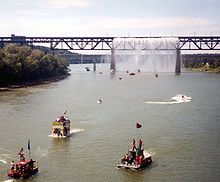 The 2001 Sourdough Raft Race, passing beneath the High Level Bridge's Great Divide waterfall during Klondike Days.
The 2001 Sourdough Raft Race, passing beneath the High Level Bridge's Great Divide waterfall during Klondike Days.
Edmonton plays host to several large festivals each year, contributing to its local nickname, "The Festival City."[122] Downtown Edmonton's Churchill Square host numerous festivals each summer. The Works Art & Design Festival, which takes place from late June to early July, showcases Canadian and international art and design from well-known award-winning artists as well as emerging and student artists. The Edmonton International Street Performer's Festival[123] takes place in mid-July and showcases street performance artists from around the world.
Edmonton's main summer festival is Capital EX (formerly Klondike Days). Klondike Days (or K-Days) was originally an annual fair and exhibition that eventually adopted a gold rush theme. In early 2006, it was decided that the festival would be renamed "The Capital City Exhibition" ("Capital EX"). Activities include chuckwagon races, carnival rides and fairways, music, trade shows, and daily fireworks.[124] Since 1960, the Sourdough Raft Races have also been a popular event.[125] Later in November, Edmonton plays host to the Canadian Finals Rodeo and Farmfair; this is a significant event in Canada's rodeo circuit and second only to the National Finals Rodeo in Las Vegas in prestige.[126]
The Edmonton International Fringe Festival, which takes place in mid-August, is the largest fringe theatre festival in North America and second only to the Edinburgh Fringe Festival worldwide.[127] In August, Edmonton is also host to the Edmonton Folk Music Festival, one of the most successful and popular folk music festivals in North America.[128] Another major summer festival is the Edmonton Heritage Festival, which is an ethnocultural festival that takes place in Hawrelak Park on the Heritage Day long weekend.[129] Many other festivals exist, such as the Free Will Shakespeare Festival, the Dragon Boat Festival,[130] the Whyte Avenue Art Walk, and the Edmonton International Film Festival.
Music
Edmonton is home to a thriving music scene. Along with the Edmonton Symphony Orchestra, notable past and present local musicians include Faunts, Tommy Banks, Cadence Weapon, Captain Tractor, Five O'Clock Charlie, Kreesha Turner, Mad Bomber Society, The Mark Birtles Project, P.J. Perry, The Smalls, SNFU, Social Code, Stereos, Ten Second Epic, Tupelo Honey, Christian Hansen & The Autistics, Hot Panda, Shout Out Out Out Out, and numerous others.
Sports and recreation
Edmonton has numerous professional sports teams,[131] including the Edmonton Eskimos of the Canadian Football League, Edmonton Oilers of the National Hockey League, Edmonton Capitals of the North American League, Edmonton Rush of the National Lacrosse League, Edmonton Energy of the International Basketball League, and FC Edmonton of the North American Soccer League. Junior sports clubs include the Edmonton Huskies and Edmonton Wildcats of the Canadian Junior Football League and the Edmonton Oil Kings of the Western Hockey League. Venues for Edmonton's professional and junior sports teams include Commonwealth Stadium (Eskimos), Rexall Place (Oilers, Rush and Oil Kings), Telus Field (Capitals), the Universiade Pavilion (Energy), Foote Field (FC Edmonton), and Clarke Stadium (Huskies and Wildcats). Edmonton's teams have rivalries with Calgary's teams.
Past notable hockey teams in Edmonton include the original junior hockey incarnation of the Edmonton Oil Kings of the Western Hockey League and the Edmonton Roadrunners of the American Hockey League. Other past notable sports teams include the Edmonton Grads, a women's basketball team, and the Edmonton Trappers, a former baseball team in the Pacific Coast League.
Local university-level sports teams include the U of A Golden Bears, the U of A Pandas, the NAIT Ooks, and the Grant MacEwan Griffins. Local amateur teams, among others, include the Edmonton Gold of the Rugby Canada Super League and the Oil City Derbygirls in a flat track roller derby league.[132]
Since 2005, Edmonton has hosted an annual circuit on the Indy Racing League known as the Edmonton Indy (formerly the Grand Prix of Edmonton). In addition, Castrol Raceway hosts regular sprint car and a national IHRA events at their facility next to Edmonton International Airport.[133]
Past sporting events hosted by Edmonton include the 1978 Commonwealth Games, the 1983 World University Games (Universiade), the 2001 World Championships in Athletics, the 2002 World Ringette Championships, the 2005 World Master Games,[134] the 2006 Women's Rugby World Cup, the 2007 FIFA U-20 World Cup[135], the CN Canadian Women's Open, and the 2010 Canadian National Debating Championship. Edmonton is sharing hosting duties with Calgary for the 2012 World Junior Ice Hockey Championships.
Current professional sports teams Club Type League Venue Established Championships Edmonton Eskimos Canadian football Canadian Football League Commonwealth Stadium 1949 13 Edmonton Oilers Ice hockey National Hockey League Rexall Place 1972 5 Edmonton Capitals Baseball North American League Telus Field 2005 1 Edmonton Rush Indoor lacrosse National Lacrosse League Rexall Place 2005 0 Edmonton Energy Basketball International Basketball League Universiade Pavilion 2008 0 FC Edmonton Soccer North American Soccer League Foote Field 2010 0 Current amateur and junior clubs Club Type League Venue Established Championships Edmonton Huskies Canadian football Canadian Junior Football League Clarke Stadium 1947 5 Edmonton Wildcats Canadian football Canadian Junior Football League Clarke Stadium 1948 2 Edmonton Chimos Ice hockey Western Women's Hockey League River Cree Resort Twin Arena / Jubilee Recreation Centre 1973 0 Edmonton Gold Rugby union Rugby Canada Super League Ellerslie Rugby Park 1998 0 Edmonton WAM! Ringette National Ringette League Callingwood Twin Arena 2001 4 Edmonton Stallions Canadian football Alberta Football League Foote Field 2001 2 Edmonton Prospects Baseball Western Major Baseball League John Fry Park 2005 0 Edmonton Drillers Indoor soccer Canadian Major Indoor Soccer League Servus Credit Union Place (St. Albert) 2006 1 Edmonton Oil Kings Ice hockey Western Hockey League Rexall Place 2007 0 Education
K–12
Edmonton has three publicly funded school boards (districts) that provide kindergarten and grades 1–12. The vast majority of students attend schools in the two large English language boards: Edmonton Public Schools, and the separate Edmonton Catholic School District.[136] Also, since 1994, the Francophone minority community has had their own school board based in Edmonton, the Greater North Central Francophone Education Region No. 2, which includes surrounding communities. Most recently, the city has seen a small number of public charter schools open, independent of any board. All three school boards and public charter schools are funded through provincial grants and property taxes.
Some private schools exist as well, including Edmonton Academy and Tempo School.[137] The Edmonton Society for Christian Education[138] and Millwoods Christian School (not part of the former) used to be private schools; however, both have become part of Edmonton Public Schools as alternative programs.[139][140]
Both the Edmonton Public Schools and the Edmonton Catholic School District provide support and resources for those wishing to homeschool their children.[141]
Post secondary
Edmonton has become one of Canada's major educational centres, with more than 60,000 full time postsecondary students spread over several institutions and campuses (total enrollment among the schools is as high as 170,000, which includes students enrolled in multiple institutions).[142]
The University of Alberta (known colloquially as the U of A), whose main campus is situated on the south side of Edmonton's river valley, is a board-governed public institution with annual revenue of one billion dollars. About 36,000 students are served in more than 200 undergraduate programs and 170 graduate programs.[143] The main campus consists of more than ninety buildings on 890,000 square metres (220 acres) of land, with buildings dating back to the university's establishment in 1908. It is also home to Canada's second-largest research library, which ranks first in volumes per student, with over 10 million (in 2005)[144] and subscriptions to 13,000 full-text electronic journals and 500 electronic databases. Grant MacEwan University enrolls[145] 40,791 students in programs offering career diplomas, university transfers, and bachelor's degrees;[146]
Other universities within the borders of Edmonton include Athabasca University, Concordia University College of Alberta, The King's University College, Taylor University College and Seminary,[147] and the Edmonton campus of the University of Lethbridge.
Other Edmonton post-secondary institutions include the Northern Alberta Institute of Technology (NAIT), with 48,500 students enrolled in 190 technical, vocational, and apprenticeship programs;[148] and NorQuest College,[149] with 11,300 students, specializing in short courses in skills and academic upgrading. Edmonton is also home to the Antarctic Institute of Canada.[150]
Infrastructure
Transportation
Air
Edmonton is a major air transportation gateway to northern Alberta and northern Canada.[151] The Edmonton International Airport (EIA) and Edmonton City Centre Airport (ECCA) are the two airports serving the city.[23]
The EIA, being the larger of the two airports, provides passenger service to destinations in the United States, Europe, Mexico, and the Caribbean. The EIA is located within Leduc County, adjacent to the City of Leduc and the Nisku Industrial Business Park.
The ECCA is a general aviation facility (since air services consolidation in 1995) and the only airport located within the city limits. The ECCA is home to a variety of aviation companies with key markets in northern Alberta.[23] The ECCA is currently in the process of being closed by the city, and redeveloped into a transit orientated development, connected to the NAIT LRT expansion.
With direct air distances from Edmonton to places such as London in Europe being shorter than to other main airports in western North America,[152] Edmonton Airports is working to establish a major container shipping hub called Port Alberta.[153]
Rail
Edmonton serves as a major transportation hub for Canadian National Railway, whose North American operations management centre is located at their Edmonton offices. It is also tied into the Canadian Pacific Railway network, which provides service from Calgary to the south and extends northeast of Edmonton to serve Alberta's Industrial Heartland.
Inter-city rail passenger rail service is operated by Via Rail from the Edmonton railway station to Jasper National Park, Saskatchewan, and British Columbia.[154]
Public transit
The Edmonton Transit System is the city's main public transit agency, operating the Edmonton Light Rail Transit (LRT) line as well as a large fleet of buses.[155] Approximately 34% of people in the Edmonton Capital Region (mostly from Edmonton proper) use ETS per day (354,440 [156][157] out of 1,034,945 [158]). There are approximately 280,000 bus riders on average per day using Edmonton Transit System.[156]
From the 1990s to early 2009, Edmonton was one of two cities in Canada still operating trolleybuses, along with Vancouver. On June 18, 2008, City Council decided to abandon the system[159] and the last trolleybus ran on May 2, 2009.[160][161]
Scheduled LRT service began on April 23, 1978, with five extensions of the single line completed since.[162] The original Edmonton line is considered to be the first "modern" light rail line in North America (i.e., built from scratch, rather than being an upgrade of an old system). It introduced the use of German-designed rolling stock that subsequently became the standard light rail vehicle of the United States.[162] The Edmonton "proof-of-payment" fare collection system adopted in 1980—modelled after European ticket systems—became the North American transit industry's preferred approach for subsequent light rail projects.[163] The four-year South LRT extension was opened in full on April 24, 2010, which sees trains travelling to Century Park[42] (located at 23 Avenue and 111 Street), making stops at South Campus and Southgate Centre along the way.[42] Edmonton is also looking into plans to expand LRT to Mill Woods and the West side[164] by 2016 [165] using low floor technology, along with a line to NAIT in north-central Edmonton using the high floor style present in the current line by 2014.[166]
Roads
A largely gridded system forms most of Edmonton's street and road network.[167] The address system is mostly numbered, with streets running south to north and avenues running east to west. In built-up areas built since the 1950s, local streets and major roadways generally do not conform to the grid system. Major roadways include Yellowhead Trail (Alberta Highway 16) and Whitemud Drive, and the city is connected to other communities elsewhere in Alberta, British Columbia, and Saskatchewan via the Yellowhead Highway to the west and east and the Queen Elizabeth II Highway (Alberta Highway 2) to the south.[168][169]
Trail system
There is an extensive multi-use trail system for bicycles and pedestrians throughout the city; however, most of this is within the river valley parkland system.[170]
Waste disposal
The Edmonton Composting Facility, the largest of its type in the world, is also the largest stainless steel building in North America.[171] By 2013, the city anticipates that it will divert more than 90% of the city's household waste from the landfills.[171] Among the innovative uses for the city's waste includes a Christmas tree recycling program. The trees are collected each January and put through a woodchipper; this material is used as an addition to the composting process. In addition, the wood chips absorb much of the odour produced by the compost by providing a biofilter element to trap odour causing gaseous results of the process.[172]
Together, the Waste Management Centre and Wastewater Treatment plant are known as the Edmonton Waste Management Centre of Excellence. Research partners include the University of Alberta, the Alberta Research Council, the Northern Alberta Institute of Technology, and Olds College.[173]
Electricity and water distribution systems
Edmonton's first power company established itself in 1891 and installed streetlights along the city's main avenue, Jasper Avenue. The power company was bought by the Town of Edmonton in 1902 and remains under municipal ownership today as EPCOR. Also in charge of water treatment, in 2002 EPCOR installed the world's largest ultraviolet (UV) water treatment or ultraviolet disinfection system at its E.L. Smith Water Treatment Plant.[174]
Health care
There are four main hospitals serving Edmonton: University of Alberta Hospital, Royal Alexandra Hospital, Misericordia Community Hospital, and Grey Nuns Community Hospital.[175] Other area hospitals include Sturgeon Community Hospital in St. Albert, Leduc Community Hospital in Leduc, Westview Health Centre in Stony Plain, and Fort Saskatchewan Health Centre in Fort Saskatchewan. Dedicated psychiatric care is provided at the Alberta Hospital. The Northeast Community Health Centre offers a 24-hour emergency room with no inpatient ward services. The University of Alberta Hospital is the centre of a larger complex of hospitals and clinics located adjacent to the university campus which comprises the Stollery Children's Hospital, Mazankowski Alberta Heart Institute, Cross Cancer Institute, Zeidler Gastrointestinal Health Centre, Ledcor Clinical Training Centre, and Edmonton Clinic, which is currently under construction. Several health research institutes, including the Heritage Medical Research Centre, Medical Sciences Building, Katz Group Centre for Pharmacy and Health Research, and Li Ka Shing Centre for Health Research Innovation, are also located at this site. A similar set-up is also evident at the Royal Alexandra Hospital, which is connected to the Lois Hole Hospital for Women and Orthopaedic Surgery Centre. All hospitals are under the administration of Alberta Health Services, although Misericordia and Grey Nuns are run separately by the Covenant Health.[176]
Military
Edmonton is home to 1 Canadian Mechanized Brigade Group (1 CMBG), the Regular Force army brigade group of Land Force Western Area of the Canadian Forces Land Force Command. Units in 1 CMBG include Lord Strathcona's Horse (Royal Canadians); 1 Combat Engineer Regiment; two of the three regular force battalions of Princess Patricia's Canadian Light Infantry; and various headquarters, service, and support elements. Although not part of 1 CMBG, 408 Tactical Helicopter Squadron and 1 Field Ambulance are located with the brigade group; all of these units are located at Lancaster Park, immediately north of the city. From 1943, as CFB Namao (now CFB Edmonton/Edmonton Garrison), it was a major air force base,[177] and in 1996, the aviation units were transferred to CFB Cold Lake.
The Canadian Airborne Training Centre had been located in the city in the 1980s. The move of 1 CMBG and component units from Calgary occurred in 1996 in what was described as a cost-saving measure.[178] The brigade had existed in Calgary since the 1950s, and Lord Strathcona's Horse had traditionally been a Calgary garrison unit dating back to before the First World War.
Edmonton also has a large army reserve element from 41 Canadian Brigade Group (41 CBG), including The Loyal Edmonton Regiment (4th Battalion, Princess Patricia's Canadian Light Infantry); 41 Combat Engineer Regiment; HQ Battery, 20th Field Artillery Regiment; and B Squadron of The South Alberta Light Horse, one of Alberta's oldest army reserve units. Despite being far from Canada's coasts, Edmonton is also the home of HMCS Nonsuch,[179] a Naval Reserve division. There are numerous cadet corps[180] of the different elements (Sea, Army and Air Force) within Edmonton as well.
Media
Edmonton has eight local broadcast television stations shown on basic cable TV or over-the-air. Most of Edmonton's conventional television stations have made the switch to over-the-air digital broadcasting. The cable television providers in Edmonton are Telus (for IPTV) and Shaw Cable. Previously, network programming from the United States was received on cable via affiliates from Spokane, Washington, but local viewers now have more choice, given the advances with cable or satellite television that are now being offered as digital or HD (high definition) service. Broadcasts from both eastern and western locations in the United States can be viewed.
Twenty-one FM and eight AM radio stations are based in Edmonton.
Edmonton has two large-circulation daily newspapers, the Edmonton Journal and the Edmonton Sun. Other city-wide weekday publications include Metro and 24 Hours. See Magazine and Vue Weekly are both published on a weekly basis. The Edmonton Examiner is a city-wide community based paper also published weekly. There are also a number of smaller weekly and community newspapers.
Sister cities
Edmonton has four sister cities, as designated by Sister Cities International:
 Gatineau, Canada, since 1967
Gatineau, Canada, since 1967 Harbin, China, since 1985
Harbin, China, since 1985 Nashville, United States, since 1990
Nashville, United States, since 1990 Wonju, South Korea, 1998
Wonju, South Korea, 1998
See also
- List of communities in Alberta
- List of cities in Alberta
- List of mayors of Edmonton
- List of people from Edmonton
- List of attractions and landmarks in Edmonton
- List of tallest buildings in Edmonton
Notes
- ^ "Defending 'Deadmonton' from British blitz". BBC News. August 9, 2001. http://news.bbc.co.uk/2/hi/uk_news/1482767.stm. Retrieved August 2, 2011.
- ^ Kaufmann, Bill (August 1, 2011). "Economy to blame for 'Deadmonton' bloodshed?". Sun News Network. http://www.sunnewsnetwork.ca/sunnews/canada/archives/2011/08/20110801-205534.html. Retrieved August 2, 2011.
- ^ Alberta Municipal Affairs (2010-09-17). "Municipal Profile – City of Edmonton". http://www.municipalaffairs.alberta.ca/cfml/MunicipalProfiles/index.cfm?fuseaction=BasicReport&MunicipalityType=CITY&stakeholder=98&profileType=HIST&profileType=CONT&profileType=STAT&profileType=FINA&profileType=GRAN&profileType=TAXR&profileType=ASSE. Retrieved 2010-10-02.
- ^ a b c d e f g h Statistics Canada 2006 Census (Sept 11, 2007) Edmonton (City) 2006 Community Profile. Catalogue no. 92-591-XWE. Ottawa. Retrieved on October 27, 2007
- ^ a b c d Statistics Canada 2006 Census (Sept 11, 2007) Edmonton (Census Metropolitan Area) 2006 Community Profile. Catalogue no. 92-591-XWE. Ottawa. Retrieved on October 27, 2007
- ^ Edmonton Market Profile
- ^ a b City of Edmonton. "Municipal Census". http://www.edmonton.ca/city_government/municipal-census.aspx. Retrieved 2009-06-10.
- ^ "Annual population estimates and demographic factors of growth by census metropolitan area, Canada, from July to June — Population estimates and factors of growth". Statistics Canada. August 10, 2010. http://www.statcan.gc.ca/pub/91-214-x/2008000/t021-eng.htm. Retrieved February 10, 2010.
- ^ Aubrey, Merrily (2004). Naming Edmonton: From Ada to Zoie. University of Alberta Pr. pp. 17, 25, 34, 138, 214. ISBN 088864423X.
- ^ The Diavik Diamond Mine. "Historical The Diavik Diamond Mine". http://www.infomine.com/careers/eoc/diavik.asp. Retrieved 2009-03-01.
- ^ Edmonton Tourism. "Edmonton Festival City". Archived from the original on October 27, 2007. http://web.archive.org/web/20071027153520/http://www.festivalcity.ca. Retrieved 2007-10-27.
- ^ a b West Edmonton Mall. "Welcome to West Edmonton Mall's Website". West Edmonton Mall. http://www.wem.ca/#/main/home/Main-Home. Retrieved 2009-02-27.
- ^ Marketwire. "Edmonton Attractions Make Canada's Festival City a Family Affair". http://www.marketwire.com/press-release/Edmonton-Tourism-962120.html. Retrieved 2009-02-27.
- ^ Heritage Fiddler Mural. "Historical". http://www.muralmosaic.com/Livia/mural.html. Retrieved 2009-02-27.
- ^ Walls, Martha (2007). Edmonton Book of Everything. Maclntyre Purcell Publishing Inc.. p. 9. ISBN 9780973806342.
- ^ MacGregor, James (1975). Edmonton: A History. Hurtig, 1975 Original from the University of Michigan Digitized 5 January 2007. p. 17. ISBN 0888301006.
- ^ Real Estate Marketing services. "Historical". http://www.edmontonalberta.net/history.html. Retrieved 2009-02-27.
- ^ City of Edmonton. "Population, Historical" (PDF). City of Edmonton. Archived from the original on 2007-06-05. http://web.archive.org/web/20070605125003/http://www.edmonton.ca/infraplan/demographic/Edmonton+Population+Historical.pdf. Retrieved 2007-02-26.
- ^ The Canadian Encyclopedia. "Historical". http://www.thecanadianencyclopedia.com/index.cfm?PgNm=TCE&Params=U1ARTU0001095. Retrieved 2009-02-27.
- ^ "Edmonton, Alberta (2004)". Canadian Railway Hall of Fame. http://www.railfame.ca/sec_ind/communities/en_2004_Edmonton_Ab.asp. Retrieved 2009-05-03.
- ^ City of Edmonton. "Ward System (1970 - Present)". City of Edmonton. http://www.edmonton.ca/city_government/municipal_elections/ward-system.aspx. Retrieved 2009-03 23.
- ^ City of Edmonton. "Population, Historical" (PDF). City of Edmonton. http://webdocs.edmonton.ca/InfraPlan/demographic/Edmonton%20Population%20Historical.pdf. Retrieved 2007-02-26.
- ^ a b c Edmonton Airports. "Historical". http://corporate.flyeia.com/general_aviation/edmonton_city_centre/history. Retrieved 2009-02 27.
- ^ Canadian Geographical Journal. Historical. http://www.historycooperative.org/journals/eh/12.4/lackenbauer.html. Retrieved 2009-03-01.
- ^ "Edmonton Geography". The Canadian Encyclopedia. http://www.thecanadianencyclopedia.com/index.cfm?PgNm=TCE&Params=A1ARTA0002525. Retrieved 25 February 2010.
- ^ Jim Willet. "Edmonton River Valley". Edmonton River Valley. http://www.edmontonrivervalley.com/history.html. Retrieved 2009-02-27.
- ^ Randall Morck. "Edmonton Two Hours from the Rockies?". Alberta School of Business. http://apps.business.ualberta.ca/rmorck/Columns/Nordegg%20highway.pdf. Retrieved 2009-03-06.
- ^ The Canadian Heritage Rivers System. "North Saskatchewan". http://www.chrs.ca/Rivers/NorthSask/NorthSask-F_e.htm. Retrieved 2009-03-06.
- ^ Lawrence Herzog. "Industry on the river". Real Estate Weekly. http://www.rewedmonton.ca/content_view_rew?CONTENT_ID=1785. Retrieved 2009-03-06.
- ^ Mining Exploration News. "Project of Gold Copper Mine Exploration Near Edmonton Delay". http://paguntaka.org/2008/08/30/project-of-gold-copper-mine-exploration-near-edmonton-delay/. Retrieved 2009-03-06.
- ^ a b Edmonton's Official Tourism Website. "Parkland and environment". Edmonton's Official Tourism Website. http://www.edmonton.com/tourism/travel_media/page.asp?page=1603. Retrieved 2009-02-27.
- ^ City of Edmonton, Transportation Department (January 2007). "Edmonton Roadway Bicycle Map". City of Edmonton. Archived from the original on 2009-11-17. http://www.webcitation.org/5lML5dnjE. Retrieved 2009-09-11.
- ^ Heritage Community Foundation. "Parkland and environment". Alberta Online Encyclopedia. http://www.abheritage.ca/famous5/leadership/individually.html. Retrieved 2009-02-27.
- ^ The City of Edmonton. "Selection List of Common Tree Species". http://www.edmonton.ca/environmental/conservation_landscaping/selection-list-of-common-tree.aspx. Retrieved 2009-02-27.
- ^ Barkley, Shelley (2007-05-22). "Juglans sp. (Butternut/Walnut)". Government of Alberta. http://www1.agric.gov.ab.ca/$department/deptdocs.nsf/all/opp4044?opendocument=. Retrieved 2007-10-27.
- ^ Edmonton Golf. "Parkland and environment". http://www.edmontongolf.com/. Retrieved 2009-02-27.
- ^ "Edmonton - Ice and Snow". City of Edmonton. http://webcache.googleusercontent.com/search?q=cache:dtEkebKoopoJ:www.edmonton.ca/assets/ParksRiver/Winter_Rec_Guide08-web.pdf+edmonton+winter+recreation&cd=2&hl=en&ct=clnk&gl=ca. Retrieved 21 November 2009.
- ^ Edmonton Federation of Community Leagues. "Edmonton Federation of Community Leagues". Edmonton Federation of Community Leagues. http://www.efcl.org/. Retrieved 2009-02-17.
- ^ a b The City of Edmonton. "Edmonton Maps". http://maps.edmonton.ca/Scripts/main.asp. Retrieved 2009-03-06.
- ^ City of Edmonton, Planning. "Fort Road Old Town Redevelopment". City of Edmonton. http://www.edmonton.ca/city_government/planning_development/old-town-fort-road-redevelopment.aspx. Retrieved 2009-02-17.
- ^ Century Park Club and Residences. "centuryCentral". ProCura. http://www.centurypark.ca/. Retrieved 2007-10-27.
- ^ a b c City of Edmonton. "South LRT Extension" (PDF). City of Edmonton and ETS. http://www.edmonton.ca/transportation/ets/lrt_projects/south-lrt-extension.aspx. Retrieved 2009-02-27.
- ^ Plunkett, T.J. (1982). "Tribunals, Politics, and the Public Interest: The Edmonton Annexation Case". Canadian Public Policy (University of Toronto Press) 8 (2): 207–221. doi:10.2307/3550157. JSTOR 3550157.
- ^ Leduc Representative (2005-07-14). "Edmonton shelves airport annexation talks". http://www.leducrep.com/ArticleDisplay.aspx?archive=true&e=1863471. Retrieved 2010-02-11.
- ^ Province of Alberta (1964-04-30). "Board Order No. 1234". http://www.municipalaffairs.alberta.ca/cfml/pdf_search/pdf/CITY/0098/Edmonton_Gaz_BO_1234_1964_No42.pdf. Retrieved 2010-02-11.
- ^ Province of Alberta (1981-06-11). "Order in Council (O.C.) No. 538/81". http://www.municipalaffairs.alberta.ca/cfml/pdf_search/pdf/CITY/0098/Edmonton_OC_538_81_1982_No6.pdf. Retrieved 2010-02-11.
- ^ Province of Alberta (2008-04-15). "Order in Council (O.C.) No. 127/2008". http://www.qp.alberta.ca/documents/orders/orders_in_council/2008/408/2008_127.html. Retrieved 2010-02-11.
- ^ "The Atlas of Canada". Natural Resources Canada. http://atlas.nrcan.gc.ca/site/english/maps/environment/forest/forestcanada/planthardi. Retrieved 2 April 2010.
- ^ "Agroclimatic Atlas of Alberta: Climate of Alberta". Government of Alberta. http://www1.agric.gov.ab.ca/$department/deptdocs.nsf/all/sag6299. Retrieved 19 January 2010.
- ^ "Agroclimatic Atlas of Alberta: Introduction". Government of Alberta. http://www1.agric.gov.ab.ca/$department/deptdocs.nsf/all/sag6278/$FILE/sag6278_lrg.gif. Retrieved 26 January 2010.
- ^ a b c d e f g "Canadian Climate Normals 1971–2000, Edmonton City Centre Airport". Environment Canada. 2004-02-25. http://climate.weatheroffice.gc.ca/climate_normals/results_e.html?stnID=1867&lang=e&dCode=1&province=ALTA&provBut=&month1=0&month2=12. Retrieved 2007-10-28.
- ^ Martha, Walls (2007). Edmonton Book of Everything. Maclntyre Purcell Publishing Inc.. pp. 62, 64. ISBN 9780973806342.
- ^ "Climate Data Almanac for January 26, Edmonton City Centre A, AB". Climate Data Almanac. Environment Canada. 21 June 2002. http://www.climate.weatheroffice.ec.gc.ca/climateData/hourlydata_e.html?timeframe=1&Prov=XX&StationID=1867&Year=1972&Month=1&Day=26. Retrieved 11 December 2008.
- ^ "Climate Data Almanac for January 19, Edmonton, AB". Climate Data Almanac. Environment Canada. 20 April 2004. http://www.climate.weatheroffice.ec.gc.ca/climateData/almanac_e.html?timeframe=4&Prov=XX&StationID=1863&Year=2007&Month=1&Day=19. Retrieved 28 October 2007.
- ^ "Frost Chart for Canada". Frost Chart for Canada. The Old Farmer's Almanac. September 20, 2010. http://www.almanac.com/content/frost-chart-canada. Retrieved 20 September 2010.
- ^ Walls, Martha (2007). Edmonton Book of Everything. Maclntyre Purcell Publishing Inc.. p. 62. ISBN 9780973806342.
- ^ Rao, Joe (2008-06-13). "Summer's Twilight Zones". Live Science. http://www.climates.com/CANADA/PDF/AB003CAN.pdf. Retrieved 2009-01-29.
- ^ "Remembering Black Friday: July 31, 1987". CBC. July 25, 2007. http://archives.cbc.ca/environment/extreme_weather/topics/1713-11760/. Retrieved 2 November 2010.
- ^ "The Edmonton Hailstorm of 2004". University of Alberta, Meteorological Service of Canada. http://collaboration.cmc.ec.gc.ca/science/arma/cmos_2005/Brimelow_Julian_CMOS_2005.pdf. Retrieved 16 April 2011.
- ^ CBC (2004-07-12). "Adjusters assess storm damage to West Edmonton Mall". CBC News. http://www.cbc.ca/canada/story/2004/07/12/edmonton_storm_new040712.html. Retrieved 2009-02-27.
- ^ "Daily Data Report for March 2004". Environment Canada. March 2004. http://climate.weatheroffice.gc.ca/climateData/dailydata_e.html?Prov=XX&timeframe=2&StationID=1867&Day=1&Month=3&Year=2004&cmdB1=Go. Retrieved 25 March 2010.
- ^ Alberta Municipal Affairs (2009-09-15). "Alberta 2009 Official Population List". http://municipalaffairs.gov.ab.ca/documents/LGS/2009pop.pdf. Retrieved 2010-09-12.
- ^ Government of Canada. "Ethnic origins, 2006 counts, for census subdivisions (municipalities) with 5,000-plus population - 20% sample data". http://www12.statcan.ca/english/census06/data/topics/RetrieveProductTable.cfm?ALEVEL=3&APATH=3&CATNO=&DETAIL=0&DIM=&DS=99&FL=0&FREE=0&GAL=0&GC=99&GK=NA&GRP=1&IPS=&METH=0&ORDER=1&PID=92333&PTYPE=88971&RL=0&S=1&SUB=0&ShowAll=No&StartRow=1&Temporal=2006&Theme=80&VID=0&VNAMEE=&VNAMEF=&GID=838054. Retrieved 2009-02-27.
- ^ Statistics Canada (2007-02-01). "2001 Census- Religion by population in Edmonton". Government of Canada. http://www12.statcan.ca/english/Profil01/CP01/Details/Page.cfm?Lang=E&Geo1=CSD&Code1=4811061&Geo2=PR&Code2=48&Data=Count&SearchText=Edmonton&SearchType=Begins&SearchPR=48&B1=All&Custom=. Retrieved 2009-03-26.
- ^ "Al-Rashid Mosque". The Friday Bulletin. http://muslim-canada.org/alrashidmosque.html. Retrieved 2009-02-28.
- ^ "Hindu Society of Alberta". The Friday Bulletin. http://www.hindusociety.ab.ca. Retrieved 2009-02-28.
- ^ Maha Ganapathy Temple (Hindu Temple). "Maha Ganapathy Temple (Hindu Temple)". http://www.mahaganapathytemple.com. Retrieved 2009-02-28.
- ^ Jewish Federation of Edmonton. "Jewish Federation of Edmonton". http://www.jewishedmonton.org/index.aspx?page=1. Retrieved 2009-02-28.
- ^ Synagogues in Edmonton. "Synagogues in Edmonton". http://www.jewishedmonton.org/IR/CategoryListings.aspx?id=23939. Retrieved 2009-02-28.
- ^ "Welcome to the Unitarian Church of Edmonton". Unitarian Church of Edmonton. http://www.uce.ca/. Retrieved 4 May 2010.
- ^ "Welcome to Westwood". Westwood Unitarian Congregation. http://www.westwoodunitarian.ca/. Retrieved 28 March 2010.
- ^ Canadian Unitarian Council. "Congregations in Alberta". http://cuc.ca/congregations/index.htm#AB. Retrieved 2009-11-16.
- ^ a b Walls, Martha (2007). Edmonton Book of Everything. Maclntyre Purcell Publishing Inc.. p. 129. ISBN 9780973806342.
- ^ "Ward System". City of Edmonton. July 22, 2009. http://www.edmonton.ca/city_government/municipal_elections/ward-system.aspx. Retrieved 2009-08-05.
- ^ "Members Information". Legislative Assembly of Alberta. http://www.assembly.ab.ca/net/index.aspx?p=mla_home. Retrieved 27 March 2010.
- ^ Edmonton Economic Development Corporation (2007-09-25). "Edmonton.com: Statistics and Reference Information—GDP". City of Edmonton. Archived from the original on October 12, 2007. http://web.archive.org/web/20071012115712/http://www.edmonton.com/statistics/page.asp?page=75. Retrieved 2007-10-28.
- ^ Overseas Property Mall in Canadian Property, Guides and Tips. "Edmonton Canada Market Outlook". http://www.overseaspropertymall.com/buying-property/guides-and-tips/edmonton-canada-market-outlook/. Retrieved 2009-03-06.
- ^ OMAC. "Edmonton Market Profile". http://www.omaccanada.ca/en/market/edmonton/default.omac. Retrieved 2009-03-06.
- ^ "Alberta Fact Sheet". Government of Alberta. http://www.advancededandtech.alberta.ca/media/216155/alberta%20produces%20fact%20sheet.pdf. Retrieved 2009-10-26.
- ^ Edmonton Economic Development Corporation (June 2010). "Edmonton's Diverse Economy". City of Edmonton. http://www.edmonton.com/for-business/edmontons-diverse-economy.aspx. Retrieved 2010-06-18.
- ^ NAIT. "NAIT Graduate Employment Survey Cited Employers". https://www.nait.ca/portal/server.pt/gateway/PTARGS_0_99_10439_0_0_18/Computer%20Systems%20Technology.pdf. Retrieved 2009-03-06.
- ^ University of Alberta Faculty of Engineering. "U of A Receives $15 Million for Nanosystems Research Facility". University of Alberta Faculty of Engineering. http://www.engineering.ualberta.ca/nav02.cfm?nav02=30429&nav01=18430. Retrieved 2009-03-06.
- ^ Alberta's Real Estate History. "The Era of Urban Growth (1961-1981)". http://www.albertasource.ca/realestate/industry/hist_urban_growth.html. Retrieved 2009-03-06.
- ^ The Canadian Encyclopedia. "Canadian Commercial Bank". http://www.thecanadianencyclopedia.com/index.cfm?PgNm=TCE&Params=A1ARTA0001272. Retrieved 2009-03-06.
- ^ Canadian Western Bank Group. "Canadian Western Bank Group". http://www.cwbankgroup.com/. Retrieved 2009-03-06.
- ^ Financial Services, Edmonton. "Financial Services, Edmonton". http://relocatecanada.com/edmonton/banks.html. Retrieved 2009-03-06.
- ^ PCL. "PCL History". http://www.pcl.com/AboutUS/OurHistory.aspx. Retrieved 2009-03-06.
- ^ Stantec Inc.. "Stantec Inc". http://www.stantec.com/. Retrieved 2009-03-06.
- ^ Hoover's Company Directory. "Hoover's Company Directory". Edmonton. http://www.hoovers.com/free/geo/index.xhtml. Retrieved 2009-03-06.
- ^ Grahm Hicks. "Edmonton and the Prince Rupert Container Port". Edmonton Sun. http://blog.canoe.ca/hicksonsix/2007/09/08/edmonton_and_the_prince_rupert_container. Retrieved 2009-03-06.
- ^ Global Direct Investment Solutions. (April 23, 2007) North American Cities of the Future - 2007 fDi magazine award. Retrieved on 2008-03-17.
- ^ Edmonton Economic Development Corporation (April 24, 2007) Edmonton captures three North American ‘Cities of the Future’ Awards. Retrieved on: 2007-07-14. Archived September 29, 2007 at the Wayback Machine
- ^ Government of Alberta Department of Education and Technology. "Life Sciences News Releases". Government of Alberta Department of Education and Technology. http://www.advancededucation.gov.ab.ca/technology/wwwtechnology_asp/techprior/techcomm/lifesciences/life_sciences_news.asp. Retrieved 2009-02-27.
- ^ Edmonton Shopping Malls. "Malls In Edmonton". http://www.discoveredmonton.com/Edmonton/Shopping/ShoppingMalls/. Retrieved 2009-03-07.
- ^ South Edmonton Common. "South Edmonton Common". Archived from the original on 2008-02-12. http://web.archive.org/web/20080212095448/http://southedmontoncommon.com/index.htm. Retrieved 2009-02-28.
- ^ Collier International. "Windermere Power Center". http://www.colliersmn.com/prod/ccgrd.nsf/City/E09298390FAC34E0852574E2007779E4/$File/EdmRetailQ32008.pdf. Retrieved 2009-03-06.
- ^ Real Estate Weekly. "The Plays the Thing in Old Strathcona". http://www.rewedmonton.ca/content_view2?CONTENT_ID=139. Retrieved 2009-03-07.
- ^ Goyette, Linda (2005). Edmonton in Our Own Words. University of Alberta, 200. p. 330. ISBN 0888644493.
- ^ "Poet Laureate Edmonton". Edmonton Public Library. http://www.epl.ca/poet/news.cfm. Retrieved 2 March 2010.
- ^ Francis Winspear Centre. "Winspear Centre History". http://www.winspearcentre.com/AbouttheHall/WinspearCentreHistory/tabid/69/Default.aspx. Retrieved 2009-02-28.
- ^ Edmonton Symphony Orchestra. "Edmonton Symphony Orchestra fundraising". http://www.edmontonsymphony.com/SupporttheESO/tabid/92/Default.aspx. Retrieved 2009-02-28.
- ^ Encyclopedia of Music in Canada. "Francis Winspear Centre for Music". http://www.thecanadianencyclopedia.com/index.cfm?PgNm=TCE&Params=U1ARTU0004214. Retrieved 2009-02-27.
- ^ Citadel Theatre. "Citadel Theatre company history". http://www.citadeltheatre.com/citadel_history.php. Retrieved 2009-02-28.
- ^ Canadian Heritage. "Edmonton Cultural Capital of Canada 2007 Celebratory Projects". http://www.creativeedmonton.ca/projects.html. Retrieved 2009-03-23.
- ^ Ukrainian Dnipro Ensemble of Edmonton. "Ukrainian Dnipro Ensemble of Edmonton". http://www.dniprochoir.com/content/default.asp. Retrieved 2009-03-26.
- ^ "Edmonton Rock Formation lizard". Enchanted Learning. http://www.enchantedlearning.com/subjects/dinosaurs/dinos/Edmontosaurus.shtml. Retrieved 28 March 2010.
- ^ "Edmontosaurus". Howstuffworks. http://animals.howstuffworks.com/dinosaurs/edmontosaurus.htm. Retrieved 28 March 2010.
- ^ oldstrathcona.ca. "Revitalization". oldstrathcona.ca. http://oldstrathcona.ca/revitalization. Retrieved 2009-03-06.
- ^ Glenbow Museum. "The First Steps of Strathcona". http://oldstrathcona.ca/history. Retrieved 2009-03-06.
- ^ The City of Edmonton. "Business Revitalization Zones". http://www.edmonton.ca/city_government/planning_development/business-revitalization-zones.aspx. Retrieved 2009-03-23.
- ^ The City of Edmonton. "Welcome to Old Strathcona". http://www.oldstrathcona.ca/. Retrieved 2009-03-06.
- ^ Metro Cinema. "Metro Cinema". http://www.metrocinema.org. Retrieved 2009-02-28.
- ^ "Museums & Historical Sites". City of Edmonton. http://www.edmonton.ca/attractions_recreation/museums-historical-sites.aspx. Retrieved 16 April 2011.
- ^ Royal Alberta Museum. "Royal Alberta Museum". http://www.royalalbertamuseum.ca/general/histpma.htm. Retrieved 2009-02-28.
- ^ Alberta Railway Museum. "Alberta Railway Museum". http://www.railwaymuseum.ab.ca/. Retrieved 2009-02-28.
- ^ Telephone Historical Centre. "Telephone Historical Centre". http://www.telephonehistoricalcentre.com/. Retrieved July 27, 2011.
- ^ Valley Zoo. "Valley Zoo". http://www.valleyzoo.ca/pages/ValleyZoo/default.aspx. Retrieved 2009-02-28.
- ^ "Grand Opening". Art Gallery of Alberta. http://www.youraga.ca/about-aga/our-mission/. Retrieved 12 February 2010.
- ^ Art Gallery of Alberta. "Art Gallery of Alberta". http://www.artgalleryalberta.com/. Retrieved 2009-02-28.
- ^ University of Alberta. "Museums". http://www.museums.ualberta.ca/. Retrieved 2009-02-28.
- ^ Canada's Historic Places. "John walter museum and historical area". http://www.historicplaces.ca/visit-visite/affichage-display.aspx?id=2986. Retrieved 2009-02-28.
- ^ Edmonton Festival City. "Edmonton Festival City". Archived from the original on October 29, 2007. http://web.archive.org/web/20071029101548/http://www.festivalcity.ca/. Retrieved 2009-03-07.
- ^ Edmonton International Street Performer's Festival. "Edmonton International Street Performer's Festival". http://www.edmontonstreetfest.com/. Retrieved 2009-02-28.
- ^ Capital EX. "Capital EX". Northlands. http://www.capitalex.ca/. Retrieved 2009-02-28.
- ^ Sourdough Raft Race Association. "50th Annual Raft Race: Sunday July 12, 2009!". http://www.sourdoughraftraceassociation.com/. Retrieved 2009-02-28.
- ^ Canadian Finals Rodeo. "Canadian Finals Rodeo". Northlands. http://www.canadianfinalsrodeo.com/. Retrieved 2009-02-28.
- ^ The Fringe. "Edmonton International Fringe Festiva". http://www.fringetheatreadventures.ca/. Retrieved 2009-02-27.
- ^ Edmonton Folk Music Festival. "Edmonton Folk Music Festival". Archived from the original on August 22, 2008. http://web.archive.org/web/20080822034836/http://www.efmf.ab.ca/. Retrieved 2009-03-07.
- ^ Edmonton Heritage Festival. "Edmonton Heritage Festival". http://www.heritage-festival.com/. Retrieved 2009-03-07.
- ^ Edmonton Dragon Boat Festival Association. "Edmonton Dragon Boat Festival". http://www.edbfa.com/. Retrieved 2009-02-28.
- ^ Edmonton Public Library. "Sports History in Edmonton". Edmonton Public Library. Archived from the original on 2006-10-15. http://web.archive.org/web/20061015224038/http://www.epl.ca/EPLSportsHistory.cfm. Retrieved 2009-02-27.
- ^ Welcome to the home of the Oil City Derby Girls!
- ^ CBC News (2011-01-12). "Edmonton Indy Back This Summer". http://www.cbc.ca/canada/edmonton/story/2011/01/11/edmonton-indy-future.html. Retrieved 2011-01-18.
- ^ Edmonton Super Summer. "2005 World Masters Games". http://www.infoedmonton.com/edmonton2005/2005worldmastersgames.html. Retrieved 2009-02-27.
- ^ Rahul Vaidyanath. "FIFA U-20 World Cup". The Epoch Times. http://en.epochtimes.com/news/7-6-27/56947.html. Retrieved 2009-02-27.
- ^ Edmonton Catholic Schools. "Edmonton Catholic Schools". http://www.ecsd.net/. Retrieved 2009-02-28.
- ^ Edmonton Academy. "Edmonton Academy". http://www.edmontonacademy.com/home.html. Retrieved 2009-02-28.
- ^ Edmonton Society for Christian Education. "Edmonton Society for Christian Education". http://www.edmchristian.net/home/index.aspx. Retrieved 2009-02-28.
- ^ Edmonton Society for Christian Education. "Edmonton Society for Christian Education". http://www.edmchristian.net/OurCampuses/society.aspx?t=soc. Retrieved 2010-04-18.
- ^ Millwoods Christian School. "Millwoods Christian School". http://www.millwoodschristianschool.com/index.php?option=com_content&task=view&id=12&Itemid=27. Retrieved 2010-04-18.
- ^ Home Schooling in Edmonton. "Home Schooling in Edmonton". http://homeschooledmonton.wordpress.com/. Retrieved 2009-02-28.
- ^ City of Edmonton. "Education". Archived from the original on October 12, 2007. http://web.archive.org/web/20071012115730/http://www.edmonton.com/statistics/page.asp?page=89. Retrieved 2009-02-28.
- ^ University of Alberta. "Admissions". http://www.uofaweb.ualberta.ca/admissions/. Retrieved 2009-05-03.
- ^ "Why the U of A?". University of Alberta. http://www.registrar.ualberta.ca/ro.cfm?id=10. Retrieved 2009-10-26.
- ^ Grant MacEwan College. "Student Profile". http://www.macewan.ca/web/home/DetailsPage.cfm?id=674&MenuOption=0. Retrieved 2009-02-27.
- ^ Grant MacEwan College. "You belong at MacEwan!". http://www.macewan.ca/web/home/index.cfm. Retrieved 2009-02-28.
- ^ Taylor University College and Seminary. "Taylor University College and Seminary". http://www.taylor-edu.ca/. Retrieved 2009-02-28.
- ^ North Alberta Institute of Technology. "NAIT". http://www.nait.ca. Retrieved 2009-02-28.
- ^ NorQuest College. "NorQuest College". http://www.norquest.ca. Retrieved 2009-02-28.
- ^ Antarctic Institute of Canada. "Antarctic Institute of Canada". http://www.antarcticinstituteofcanada.ca/. Retrieved 2009-02-28.
- ^ The Canadian Encyclopedia. "Edmonton". The Canadian Encyclopedia. http://www.thecanadianencyclopedia.com/index.cfm?PgNm=TCE&Params=A1ARTA0002525. Retrieved 2009-02-27.
- ^ Edmonton Airports. "Strategic Location" (PDF). Edmonton Airports. http://corporate.flyeia.com/media/7735/437.pdf. Retrieved 2007-11-01.
- ^ Edmonton Airports (2007-11-01). "Port Alberta". Edmonton Airports. Archived from the original on 2007-10-17. http://web.archive.org/web/20071017112326/http://corporate.edmontonairports.com/business_at_the_airport/port_alberta. Retrieved 2007-11-01.
- ^ Via Rail Canada. "Train station : Edmonton (Alberta)". Via Rail Canada. http://www.viarail.ca/train-stations/en-station-edmonton-alberta.html. Retrieved 2009-02-27.
- ^ The City of Edmonton. "History of ETS". http://www.edmonton.ca/transportation/ets/about_ets/history-of-ets.aspx. Retrieved 2009-03-07.
- ^ a b City of Ottawa - Presentations (June 19): Edmonton's LRT / 280,000 per day for bus
- ^ Edmonton City Trends Q42009 / Edmonton LRT 2009 ridership 74,440/day
- ^ 2006 Community Profiles - Census Metropolitan Area/Census Agglomeration
- ^ "City Council Minutes – June 18, 2008". City of Edmonton. 2008-06-18. http://webdocs.edmonton.ca/meetings/minutes_council/cc20080618mn.doc. Retrieved 2010-09-19.
- ^ "Last Day of Trolley Operations". City of Edmonton. http://www.edmonton.ca/transportation/ets/about_ets/ets-trolley.aspx. Retrieved 2009-09-05.
- ^ "Trolleys reach end of the line". Edmonton Journal. 2008-06-19. http://www.canada.com/edmontonjournal/story.html?id=a17d9aa6-0be1-4ae9-a977-0ca5a215d1ac. Retrieved 2010-09-19.
- ^ a b Edmonton Transit System's LRT History. "Edmonton Transit System's LRT History". http://www.barp.ca/bus/lrt/edmonton/history.html. Retrieved 2009-03-07.
- ^ Edmonton's Light Rail Transit From Concept to Operations. "Edmonton's Light Rail Transit From Concept to Operations". http://pubsindex.trb.org/document/view/default.asp?lbid=174228. Retrieved 2009-03-07.
- ^ "West LRT: Downtown to Lewis Estates". City of Edmonton. http://www.edmonton.ca/transportation/ets/lrt_projects/west-lrt.aspx#xml=http://search1.edmonton.ca/texis/ThunderstoneSearchService/pdfhi.txt?query=west+lrt&pr=www.edmonton.ca&prox=page&rorder=750&rprox=250&rdfreq=0&rwfreq=0&rlead=750&rdepth=0&sufs=1&order=r&cq=&id=4c8c97091d. Retrieved 13 September 2010.
- ^ Get Edmonton LRT extensions done by 2016: Mayor Mandel | Edmonton | News | Edmonton Sun
- ^ City of Edmonton :: North LRT to NAIT
- ^ Edmonton Transit System Advisory Board. "Edmonton Transit System Advisory Board". Archived from the original on 2009-11-17. http://www.webcitation.org/5lML6KbNF. Retrieved 2009-02-27.
- ^ Trans Canada Yellowhead Highway Association. "Trans Canada Yellowhead Highway Association". http://www.transcanadayellowhead.com/. Retrieved 2009-03-07.
- ^ Government of Alberta. "Alberta Highway 2". http://www.transportation.alberta.ca/Content/docType329/Production/11x17_Provincial_Network_Map.pdf. Retrieved 2009-03-23.
- ^ The City of Edmonton. "Trail System". http://www.edmonton.ca/attractions_recreation/parks_rivervalley/trail-system.aspx. Retrieved 2009-03-06.
- ^ a b City of Edmonton. "Edmonton Composting Facility". http://www.edmonton.ca/for_residents/garbage-recycling.aspx. Retrieved 2009-02-27.
- ^ City of Edmonton. "Edmonton Composting Facility". http://www.edmonton.ca/for_residents/garbage_recycling/edmonton-composting-facility.aspx. Retrieved 2009-02-27.
- ^ Edmonton Waste Management Centre of Excellence. "Edmonton Waste Management Centre of Excellence". http://www.ewmce.com/. Retrieved 2009-02-28.
- ^ EPCOR. "EPCOR UV". http://www.epcor.ca/en-ca/corporate-responsibility/environmental-vision/CleanerWater/Pages/UV.aspx. Retrieved 2010-11-02.
- ^ Capital Health. "Hospitals & Primary Care Facilities". http://www.capitalhealth.ca/HospitalsandHealthFacilities/Hospitals/default.htm. Retrieved 2009-02-27.
- ^ Capital Health. "Capital Heath". http://www.capitalhealth.ca/default.htm. Retrieved 2009-02-27.
- ^ Alberta's Aviation History. "CFB Namao". http://www.abheritage.ca/aviation/history/military_namao.html. Retrieved 2009-02-28.
- ^ Government of Canada. "Proceedings of the Standing Senate Committee on National Security and Defence". http://www.parl.gc.ca/38/1/parlbus/commbus/senate/Com-e/defe-e/16eva-e.htm?Language=E&Parl=38&Ses=1&comm_id=76. Retrieved 2009-02-28.
- ^ Government of Canada. "HMCS Nonsuch". http://www.navy.forces.gc.ca/navres/1/1-n_eng.asp?category=107. Retrieved 2009-02-28.
- ^ Government of Canada. "National Cadet Website". http://www.cadets.ca/home-accueil.aspx?LangType=4105. Retrieved 2009-02-28.
Further reading
- Aubrey, Merrily K (2004). Naming Edmonton : from Ada to Zoie. (Edmonton Historical Board. Heritage Sites Committee) University of Alberta Press. ISBN 088864423X. http://books.google.ca/books?id=JWWo___pkQUC&lpg=PP1&dq=Edmonton&pg=PP1#v=onepage&q&f=true
- Cashman, Tony (2002). Edmonton : stories from the river city. University of Alberta Press. ISBN 0888643926. http://books.google.ca/books?id=mJbVhqvY7TsC&lpg=PP1&dq=Edmonton&pg=PP1#v=onepage&q&f=true
- Merrett, Kathryn Chase (2001). A history of the Edmonton City Market, 1900-2000. University of Calgary Press. ISBN 1552380521. http://books.google.ca/books?id=Hfjefyb5LYEC&lpg=PA49&dq=Edmonton&pg=PP1#v=onepage&q&f=true
- Rooke, Charlene (2001). Edmonton: secrets of the city. Arsenal Pulp Press. ISBN 1551521032. http://books.google.ca/books?id=PPi5JUEliQ4C&lpg=PA1&dq=Edmonton&pg=PA1#v=onepage&q&f=true
External links
Categories:- Host cities of the Commonwealth Games
- Edmonton
- Populated places established in 1795
- Populated places established in 1904
- Hudson's Bay Company trading posts
Wikimedia Foundation. 2010.


